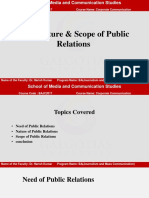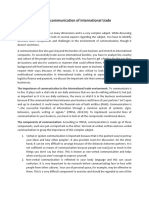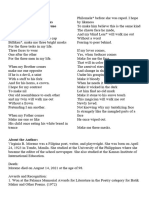0 ratings0% found this document useful (0 votes)
635 viewsReciprocal Communication
Reciprocal Communication
Uploaded by
Barbie BleuReciprocal communication refers to any communication where at least one person perceives an emotional element. It can be fully, partially, or non-reciprocal based on the degree, timing, and form of responses between individuals. Fully reciprocal communication involves compatible emotional responses from both parties. Partially reciprocal communication has inconsistent responses in degree or timing but a similar emotional message. Non-reciprocal communication contradicts the emotional content with no response or an opposing one. Participants in a study described their experiences accordingly and tended to withdraw or feel negative emotions from non-reciprocal exchanges.
Copyright:
© All Rights Reserved
Available Formats
Download as DOCX, PDF, TXT or read online from Scribd
Reciprocal Communication
Reciprocal Communication
Uploaded by
Barbie Bleu0 ratings0% found this document useful (0 votes)
635 views2 pagesReciprocal communication refers to any communication where at least one person perceives an emotional element. It can be fully, partially, or non-reciprocal based on the degree, timing, and form of responses between individuals. Fully reciprocal communication involves compatible emotional responses from both parties. Partially reciprocal communication has inconsistent responses in degree or timing but a similar emotional message. Non-reciprocal communication contradicts the emotional content with no response or an opposing one. Participants in a study described their experiences accordingly and tended to withdraw or feel negative emotions from non-reciprocal exchanges.
Copyright
© © All Rights Reserved
Available Formats
DOCX, PDF, TXT or read online from Scribd
Share this document
Did you find this document useful?
Is this content inappropriate?
Reciprocal communication refers to any communication where at least one person perceives an emotional element. It can be fully, partially, or non-reciprocal based on the degree, timing, and form of responses between individuals. Fully reciprocal communication involves compatible emotional responses from both parties. Partially reciprocal communication has inconsistent responses in degree or timing but a similar emotional message. Non-reciprocal communication contradicts the emotional content with no response or an opposing one. Participants in a study described their experiences accordingly and tended to withdraw or feel negative emotions from non-reciprocal exchanges.
Copyright:
© All Rights Reserved
Available Formats
Download as DOCX, PDF, TXT or read online from Scribd
Download as docx, pdf, or txt
0 ratings0% found this document useful (0 votes)
635 views2 pagesReciprocal Communication
Reciprocal Communication
Uploaded by
Barbie BleuReciprocal communication refers to any communication where at least one person perceives an emotional element. It can be fully, partially, or non-reciprocal based on the degree, timing, and form of responses between individuals. Fully reciprocal communication involves compatible emotional responses from both parties. Partially reciprocal communication has inconsistent responses in degree or timing but a similar emotional message. Non-reciprocal communication contradicts the emotional content with no response or an opposing one. Participants in a study described their experiences accordingly and tended to withdraw or feel negative emotions from non-reciprocal exchanges.
Copyright:
© All Rights Reserved
Available Formats
Download as DOCX, PDF, TXT or read online from Scribd
Download as docx, pdf, or txt
You are on page 1of 2
Reciprocal Communication
Reciprocal communication (RC) refers to any communication that is
experienced by at least one of the persons involved as expressing emotional content.
It is concerned with the syntax (form, timing, and degree) of an interaction only as it
contributes to the meaning derived from the experience. It is expected that the
perceived emotional equivalence of interactions will vary depending on the degree,
timing, and to a lesser extent the form of the communication.
Reciprocal communication could therefore fall into three categories: fully,
partially, and nonreciprocal. Fully reciprocal communications would include
communications in which at least one of the individuals involved experiences the
emotional content of the sending and receiving signals to be compatible. Interactions
that involve different forms than the sending signal, but is still desired and perceived
as expressing similar emotional content, would also be seen as fully reciprocal
communications. Partially, reciprocal communication would be those in which the
degree or form of the interaction is present in the allotted time, but not experienced
as completely emotionally compatible. Non-reciprocal communications would be
those in which the emotional content of the interaction is seen as contradictory.
A non-reciprocal communication would most likely be experienced when a
sending signal was given but there was no receiving response in either form or
degree within the alotted time, or when the receiving response eliminates the
possibility of reciprocation in either form or degree. Smiling at a person on the street,
and that person either showing no response or turning his back could both be seen
as non-reciprocal communication (Penrod, 2011). Reciprocal communication (RC) is
suggested, defined, and qualitatively investigated as a way of describing the
experience of emotional compatibility in communication, with an emphasis on form,
degree, and timing as fundamental aspects of nonverbal communication. Participants
of the study described fully reciprocal communication as experiencing a kind of
emotional equivalence with their partners. Regardless of the level of intention they
perceived in the communication, they assumed a fundamental connection between a
person’s emotional state and their nonverbal behavior, for themselves as well as for
their partners. Their experience of partially reciprocal communication was evident
when communication was perceived as being intentional; that is, motivated by an
underlying emotion and either asking or answering an implicit question.
Like fully reciprocal communication, participants experienced nonverbal
communication as nonreciprocal both in situations where they felt their partner was
intentionally trying to communicate and when they felt their partner was
unintentionally communicating. Generally speaking, participants tended to respond to
nonreciprocal communication by withdrawing from further communication, and
reinterpreting previous interactions. In situations where participants felt that a
nonreciprocal response was inconsistent with the message sent by previous
nonverbal communication, they expressed feelings of frustration, anger, and
resignation. It was found that participants would be more confident in interpreting
interest when the degree of the receiving response exceeds the degree of the
sending signal; tended to interpret their nonverbal communication contextually.
Finally, the distinction between form, timing, and degree is not always solid. The
amount of time a response occurs within can easily become a measure of degree
when compared with the amount of time the initial signal took place (Penrod, 2011).
You might also like
- TUGAS TUTORIAL 3 Bahasa InggrisDocument5 pagesTUGAS TUTORIAL 3 Bahasa InggrisBE100% (6)
- Test Bank For Communication Between Cultures 9th Edition Larry A SamovarDocument9 pagesTest Bank For Communication Between Cultures 9th Edition Larry A SamovarHazel Nicoll100% (37)
- Vincent RoiDocument5 pagesVincent RoiMarjorie Joy MartirNalupa AninoNo ratings yet
- The Functions of Speech Communication AreDocument4 pagesThe Functions of Speech Communication AreOcy Tojon0% (1)
- SOC LIT SOCIETY AND LITERATURE MusicDocument24 pagesSOC LIT SOCIETY AND LITERATURE MusicPhilipmark Seculles100% (1)
- Lesson 4 - Components and Formats of Business CorrespondenceDocument11 pagesLesson 4 - Components and Formats of Business CorrespondenceSherrizah ParedesNo ratings yet
- Sigmund Freud: Bertha PappenheimDocument4 pagesSigmund Freud: Bertha PappenheimJade Niña GemiraNo ratings yet
- Art Appreciation, Pre-Test & Activity 2.0Document3 pagesArt Appreciation, Pre-Test & Activity 2.0TyroneManuelPagenteOngIINo ratings yet
- Definition of LiteratureDocument7 pagesDefinition of LiteratureDewey Carlos ArgutaNo ratings yet
- President Rodrigo Duterte in His Speech During The PhilippineDocument2 pagesPresident Rodrigo Duterte in His Speech During The PhilippineImmanuel GranadaNo ratings yet
- Art Appreciation MusicDocument3 pagesArt Appreciation MusicJobelyn MalisaNo ratings yet
- What Is Global PoliticsDocument11 pagesWhat Is Global PoliticsJoshua MendezNo ratings yet
- Afro Asian LiteratureDocument8 pagesAfro Asian LiteratureElaine ManinangNo ratings yet
- Postmodern PeriodDocument2 pagesPostmodern PeriodRandy GasalaoNo ratings yet
- Business Communication - IIDocument8 pagesBusiness Communication - IIPankaj AhireNo ratings yet
- Reflection Paper On IHL Asia-Pacific Region WebinarDocument3 pagesReflection Paper On IHL Asia-Pacific Region WebinarJul A.No ratings yet
- Divisions of LiteratureDocument4 pagesDivisions of LiteratureErick Jhun Marcos Razalan100% (1)
- 25 - Film AnalysisDocument2 pages25 - Film AnalysisRufilie Daroy IINo ratings yet
- Puno Gelitphy36Document1 pagePuno Gelitphy36Francis PunoNo ratings yet
- Advanced Communication NotesDocument7 pagesAdvanced Communication NotesMitchie FaustinoNo ratings yet
- Monophthongs and DiphthongsDocument2 pagesMonophthongs and Diphthongscandygold66No ratings yet
- Conjugal Love Conjugal Love Refers To Love in A Conjugal Relationship, That Is, in A Marriage, Since The WordDocument4 pagesConjugal Love Conjugal Love Refers To Love in A Conjugal Relationship, That Is, in A Marriage, Since The WordAAQIBNo ratings yet
- Parts of Application LetterDocument11 pagesParts of Application LetterDeby Andika Dion HNo ratings yet
- Need, Nature & Scope of Public RelationsDocument10 pagesNeed, Nature & Scope of Public RelationsMs. Suruchi AgrawalNo ratings yet
- 001 Purposive-CommunicationDocument17 pages001 Purposive-CommunicationVanessa C. MaghanoyNo ratings yet
- Chapter Ii - Preactivity - Historical Background of Philippine Literature DoneDocument2 pagesChapter Ii - Preactivity - Historical Background of Philippine Literature DoneChelyn Binarao De GuzmanNo ratings yet
- Memo - Lecture NotesDocument1 pageMemo - Lecture NotesChinu Cooldude100% (1)
- Literary FormsDocument9 pagesLiterary FormsChristine Joyce Gregorio100% (1)
- Literature (From Latin Litterae (Plural) Letter) Is The Art of Written Work, and Is Not Confined ToDocument4 pagesLiterature (From Latin Litterae (Plural) Letter) Is The Art of Written Work, and Is Not Confined ToDanstan Ferrolino Genova II100% (1)
- Transactional and Interpersonal in ConversationsDocument2 pagesTransactional and Interpersonal in ConversationsFadli RafiNo ratings yet
- Cohesion and CoherenceDocument18 pagesCohesion and CoherenceAbdul MoizNo ratings yet
- J. 435 by Emily DickinsonDocument1 pageJ. 435 by Emily DickinsonRolly PeraltaNo ratings yet
- Dead Stars Feminist CRTCSMDocument27 pagesDead Stars Feminist CRTCSMJamella Claire LebunaNo ratings yet
- Berlo's SMCR Model of CommunicationDocument12 pagesBerlo's SMCR Model of CommunicationNicole MapiliNo ratings yet
- Different Types of Business CorrespondenceDocument5 pagesDifferent Types of Business CorrespondenceZainab Ara BegumNo ratings yet
- Villanueva Rejean Y. - 1 BSE-E SOC ST - LIT 111 A - LESSON 8Document7 pagesVillanueva Rejean Y. - 1 BSE-E SOC ST - LIT 111 A - LESSON 8Rejean Yap Villanueva100% (1)
- Basic and Essential Parts of A Business LetterDocument2 pagesBasic and Essential Parts of A Business LetterMikio Norberte100% (1)
- Role of Communication in International TradeDocument3 pagesRole of Communication in International TradeShawonAshrafNo ratings yet
- MIDTERM - REVIEW OF The Flight From ConversationDocument7 pagesMIDTERM - REVIEW OF The Flight From ConversationDiosary TimbolNo ratings yet
- My PC First Mod 23rdmarch2021Document26 pagesMy PC First Mod 23rdmarch2021Karyl Magno PajarojaNo ratings yet
- This Study Resource Was: Before Reading Make ConnectionsDocument6 pagesThis Study Resource Was: Before Reading Make ConnectionsAngel Joy LunetaNo ratings yet
- Online Review QuizDocument2 pagesOnline Review QuizFerl Diane Siño100% (1)
- Modern LiteratureDocument17 pagesModern LiteratureGledis GjuziNo ratings yet
- Asean Discovering Identity Amidst Diversity: LiteratureDocument5 pagesAsean Discovering Identity Amidst Diversity: LiteratureBlack BullNo ratings yet
- Exam ArtsDocument1 pageExam Artsjoanna supresencia100% (1)
- Style and RegisterDocument7 pagesStyle and RegisterIuliana GoreanuNo ratings yet
- CHAPTER V: Sexual Orientation, Gender Identity and Expression (SOGIE)Document5 pagesCHAPTER V: Sexual Orientation, Gender Identity and Expression (SOGIE)Lysander Garcia0% (1)
- Purposive CommunicationDocument14 pagesPurposive CommunicationAljen Joseph SuzaraNo ratings yet
- Poem AnalysisDocument2 pagesPoem AnalysisRhamde PillogoNo ratings yet
- Models of Communication, ExplainedDocument7 pagesModels of Communication, ExplainedKVVenkatasubramanianNo ratings yet
- LPW Criticism ExerciseDocument1 pageLPW Criticism ExerciseWrendell BrecioNo ratings yet
- Purcom ReviewerDocument11 pagesPurcom ReviewerAngel Joy CalisayNo ratings yet
- Duculan, Mizpah - 3bsn-D - Value of Phil LitDocument9 pagesDuculan, Mizpah - 3bsn-D - Value of Phil LitMizpah DuculanNo ratings yet
- Scarcity and Choice As Economic ProblemsDocument3 pagesScarcity and Choice As Economic ProblemsYohaan JNo ratings yet
- Order of MaskDocument4 pagesOrder of Maskchan DesignsNo ratings yet
- Week 16c Communication For Work PurposesDocument3 pagesWeek 16c Communication For Work PurposesAlexajane Jhackie100% (1)
- Basic Accounting Principles and ConceptsDocument3 pagesBasic Accounting Principles and ConceptsRamzan100% (1)
- Levels of Communication PDFDocument2 pagesLevels of Communication PDFNikhil PrasannaNo ratings yet
- Ethics in Business CommunicationDocument2 pagesEthics in Business CommunicationppoojashreeNo ratings yet
- Keerthi Question BankDocument65 pagesKeerthi Question BankKeerthanaNo ratings yet
- Module 5 Contextual and Content AnalysisDocument14 pagesModule 5 Contextual and Content AnalysisJoshua Ico AsisNo ratings yet
- Inbound 7797089833344847880Document3 pagesInbound 7797089833344847880picdat1k2No ratings yet
- Execution of National Hero Short EssayDocument1 pageExecution of National Hero Short EssayBarbie BleuNo ratings yet
- Rizal's Early Childhood QuizDocument1 pageRizal's Early Childhood QuizBarbie BleuNo ratings yet
- Specifically State and Explain How The Rizal Law Was PassedDocument1 pageSpecifically State and Explain How The Rizal Law Was PassedBarbie BleuNo ratings yet
- What Were The Main Purpose of Rizal La1Document1 pageWhat Were The Main Purpose of Rizal La1Barbie BleuNo ratings yet
- Agrarian Relations and The Friar Lands (Short Quiz)Document1 pageAgrarian Relations and The Friar Lands (Short Quiz)Barbie BleuNo ratings yet
- Chinese Mestizos Quiz EssayDocument1 pageChinese Mestizos Quiz EssayBarbie BleuNo ratings yet
- Key ResourcesDocument1 pageKey ResourcesBarbie BleuNo ratings yet
- AisDocument23 pagesAisBarbie BleuNo ratings yet
- How Effective Is RizalDocument1 pageHow Effective Is RizalBarbie BleuNo ratings yet
- 2.the Entrepreneurial Attributes & CultureDocument36 pages2.the Entrepreneurial Attributes & CultureBarbie BleuNo ratings yet
- Long Quiz For InvestmentDocument2 pagesLong Quiz For InvestmentBarbie BleuNo ratings yet
- PESTLE Environmental FactorDocument6 pagesPESTLE Environmental FactorBarbie BleuNo ratings yet
- Process CostingDocument46 pagesProcess CostingBarbie BleuNo ratings yet
- Name: - Section: - Unit II: Movement Skills Commonly Used in Recreational ActivitiesDocument1 pageName: - Section: - Unit II: Movement Skills Commonly Used in Recreational ActivitiesBarbie BleuNo ratings yet
- Customer Journey ExampleDocument2 pagesCustomer Journey ExampleSarlota KratochvilovaNo ratings yet
- Copywriting Assessment - Ind Assignment Brief Sept19Document1 pageCopywriting Assessment - Ind Assignment Brief Sept19Rabiah AdawiahNo ratings yet
- Peer Learning Discussion Week 9-HRTM 622Document4 pagesPeer Learning Discussion Week 9-HRTM 622tatiana.trujillo.lonNo ratings yet
- Complete Guide To Ielts Score Big in 3 Months by Amanda LynnDocument29 pagesComplete Guide To Ielts Score Big in 3 Months by Amanda Lynnjavierdb93100% (1)
- Y5 e L83 - L88 (M4)Document10 pagesY5 e L83 - L88 (M4)julie ayobNo ratings yet
- WHETHER and IF (Interchangeable)Document3 pagesWHETHER and IF (Interchangeable)BondfriendsNo ratings yet
- Effective Email Writing: Email Etiquette, Communication SkillsDocument14 pagesEffective Email Writing: Email Etiquette, Communication SkillsBELANo ratings yet
- Ed 414735Document262 pagesEd 414735ZangataNo ratings yet
- Encoding and DecodingDocument11 pagesEncoding and Decodingsambhu rNo ratings yet
- Communication Theories: Perspectives, Processes, and ContextsDocument6 pagesCommunication Theories: Perspectives, Processes, and ContextsAyantu Tesema0% (1)
- Wonders 2023 Overview BrochureDocument20 pagesWonders 2023 Overview BrochureVu Huong MaiNo ratings yet
- Teaching English For Specific Purposes - EspDocument8 pagesTeaching English For Specific Purposes - EspBambang Sardi SardiNo ratings yet
- 02 - ESOL Teacher Notes Entry 2 Unit 2Document15 pages02 - ESOL Teacher Notes Entry 2 Unit 2WayneNo ratings yet
- Approximant and SemivowelsDocument4 pagesApproximant and SemivowelsmarkcordovarojasNo ratings yet
- Typographic ExamplesDocument33 pagesTypographic Examplesapi-169903445No ratings yet
- EL - 2021 - Prelim - 4E5N P1 - QPDocument4 pagesEL - 2021 - Prelim - 4E5N P1 - QPLeng RyanNo ratings yet
- Lesson PlanDocument3 pagesLesson PlanVerónica Gabriela InfanteNo ratings yet
- Grade 6 FAST ELA ReadingDocument6 pagesGrade 6 FAST ELA Readingfiorella guzmanNo ratings yet
- October 10Document40 pagesOctober 10Supah PapahNo ratings yet
- Dashen Bank InternshipDocument5 pagesDashen Bank InternshipShewit Desta100% (3)
- Style Guide Entry - Going DottyDocument3 pagesStyle Guide Entry - Going DottyHANANE THE modestNo ratings yet
- Avanti Beginning Italian 4th Edition Aski Musumeci Solution ManualDocument8 pagesAvanti Beginning Italian 4th Edition Aski Musumeci Solution Manualwilliam100% (35)
- FPSC DictionDocument14 pagesFPSC Dictionsaimazul97No ratings yet
- Academic Writing Test 4Document5 pagesAcademic Writing Test 4AbuzarNo ratings yet
- Micro Teaching CycleDocument3 pagesMicro Teaching CycleAnand SaravananNo ratings yet
- Accuplacer Esl (Loep) : Sample Questions For StudentsDocument6 pagesAccuplacer Esl (Loep) : Sample Questions For StudentsAche NegomboNo ratings yet
- NLP Lab FileDocument66 pagesNLP Lab FileVIPIN YADAV100% (1)
- Sullivan Et Al An Instructional Model To Support Planning and TeachingDocument5 pagesSullivan Et Al An Instructional Model To Support Planning and Teachingapi-611328976No ratings yet







































































































